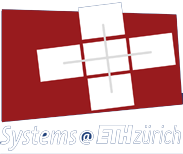Publications by Linus%20Groner
2017
Proceedings of the 26th International Symposium on High-Performance Parallel and Distributed Computing, Washington, DC, USA, June 2017
We reduce the cost of communication and synchronization in graph processing by analyzing the fastest way to process graphs: pushing the updates to a shared state or pulling the updates to a private state. We investigate the applicability of this push-pull dichotomy to various algorithms and its impact on complexity, performance, and the amount of used locks, atomics, and reads/writes. We consider 11 graph algorithms, 3 programming models, 2 graph abstractions, and various families of graphs. The conducted analysis illustrates surprising differences between push and pull variants of different algorithms in performance, speed of convergence, and code complexity; the insights are backed up by performance data from hardware counters. We use these findings to illustrate which variant is faster for each algorithm and to develop generic strategies that enable even higher speedups. Our insights can be used to accelerate graph processing engines or libraries on both massively-parallel shared-memory machines as well as distributed-memory systems.
@inproceedings{abc,
abstract = {We reduce the cost of communication and synchronization in graph processing by analyzing the fastest way to process graphs: pushing the updates to a shared state or pulling the updates to a private state. We investigate the applicability of this push-pull dichotomy to various algorithms and its impact on complexity, performance, and the amount of used locks, atomics, and reads/writes. We consider 11 graph algorithms, 3 programming models, 2 graph abstractions, and various families of graphs. The conducted analysis illustrates surprising differences between push and pull variants of different algorithms in performance, speed of convergence, and code complexity; the insights are backed up by performance data from hardware counters. We use these findings to illustrate which variant is faster for each algorithm and to develop generic strategies that enable even higher speedups. Our insights can be used to accelerate graph processing engines or libraries on both massively-parallel shared-memory machines as well as distributed-memory systems.},
author = {Maciej Besta and Michal Podstawski and Linus Groner and Edgar Solomonik and Torsten Hoefler},
booktitle = {Proceedings of the 26th International Symposium on High-Performance Parallel and Distributed Computing},
title = {To Push or To Pull: On Reducing Communication and Synchronization in Graph Computations},
venue = {Washington, DC, USA},
year = {2017}
}
Proceedings of the Algorithms and Complexity - 10th International Conference, CIAC 2017, Athens, Greece, May 2017
We investigate the multi-agent pathfinding (MAPF) problem with n agents on graphs with n vertices: Each agent has a unique start and goal vertex, with the objective of moving all agents in parallel movements to their goal s.t. each vertex and each edge may only be used by one agent at a time. We give a combinatorial classification of all graphs where this problem is solvable in general, including cases where the solvability depends on the initial agent placement.
Furthermore, we present an algorithm solving the MAPF problem in our setting, requiring O(n2)O(n2) rounds, or O(n3)O(n3) moves of individual agents. Complementing these results, we show that there are graphs where Ω(n2)Ω(n2) rounds and Ω(n3)Ω(n3) moves are required for any algorithm.
@inproceedings{abc,
abstract = {We investigate the multi-agent pathfinding (MAPF) problem with n agents on graphs with n vertices: Each agent has a unique start and goal vertex, with the objective of moving all agents in parallel movements to their goal s.t. each vertex and each edge may only be used by one agent at a time. We give a combinatorial classification of all graphs where this problem is solvable in general, including cases where the solvability depends on the initial agent placement.
Furthermore, we present an algorithm solving the MAPF problem in our setting, requiring O(n2)O(n2) rounds, or O(n3)O(n3) moves of individual agents. Complementing these results, we show that there are graphs where {\textohm}(n2){\textohm}(n2) rounds and {\textohm}(n3){\textohm}(n3) moves are required for any algorithm.},
author = {Klaus-Tycho Foerster and Linus Groner and Torsten Hoefler and Michael Koenig and Sascha Schmid and Roger Wattenhofer},
booktitle = {Proceedings of the Algorithms and Complexity - 10th International Conference, CIAC 2017},
title = {Multi-agent Pathfinding with n Agents on Graphs with n Vertices: Combinatorial Classification and Tight Algorithmic Bounds},
venue = {Athens, Greece},
year = {2017}
}

